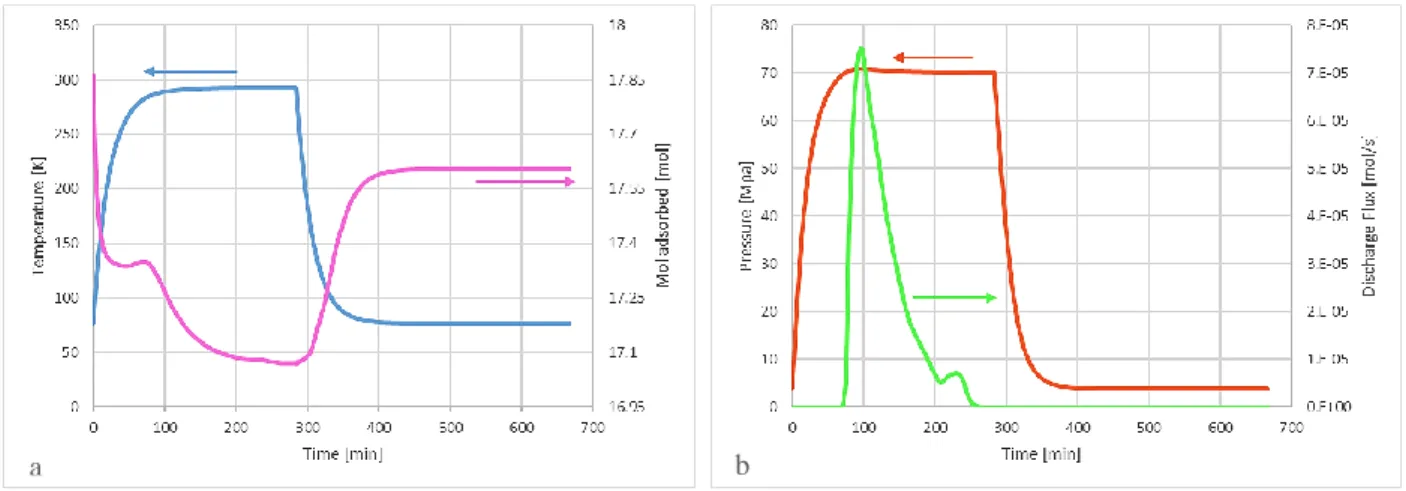HAL Id: hal-01919373
https://hal.univ-lorraine.fr/hal-01919373
Submitted on 26 Feb 2019HAL is a multi-disciplinary open access archive for the deposit and dissemination of sci-entific research documents, whether they are pub-lished or not. The documents may come from teaching and research institutions in France or abroad, or from public or private research centers.
L’archive ouverte pluridisciplinaire HAL, est destinée au dépôt et à la diffusion de documents scientifiques de niveau recherche, publiés ou non, émanant des établissements d’enseignement et de recherche français ou étrangers, des laboratoires publics ou privés.
Thermally-driven hydrogen compression based on
adsorption onto activated carbons
Giuseppe Sdanghi, Sébastien Schaefer, Nicolas Vincent, Gaël Maranzana,
Alain Celzard, Vanessa Fierro
To cite this version:
Giuseppe Sdanghi, Sébastien Schaefer, Nicolas Vincent, Gaël Maranzana, Alain Celzard, et al.. Thermally-driven hydrogen compression based on adsorption onto activated carbons. The World Conference on Carbon Materials, Jul 2018, Madrid, Spain. �hal-01919373�
THERMALLY-DRIVEN HYDROGEN COMPRESSION BASED ON ADSORPTION ONTO ACTIVATED CARBONS
G. Sdanghi1,2, S. Schaefer1, V. Nicolas1, G. Maranzana2, A. Celzard1, V. Fierro1
1Institut Jean Lamour, UMR 7198 CNRS and Université de Lorraine, Épinal, France 2 Laboratoire d'Energétique et de Mécanique Théorique et Appliquée, UMR 7563 CNRS and
Université de Lorraine, Vandœuvre-lès-Nancy, France
*Presenting author’s e-mail: vanessa.fierro@univ-lorraine.fr
Introduction
Carbon materials have received a noteworthy attention as gas storage materials due to their highly developed textural properties as well as very high surface areas, thus ensuring a complete reversible hydrogen uptake and release1. A thermally-driven hydrogen compression can be realized by using a solid bed consisting of carbon materials with high surface area and high adsorption potential, such as activated carbons (ACs), and by lowering/ increasing the system temperature. Such a compressor ensures several advantages, like absence of moving parts, no vibration, no noise and simple design. Hydrogen adsorption on two different ACs have been investigated. With the help of numerical simulations, the performances of a such thermally-driven compressor have been also analysed.
Materials and Methods
The investigated ACs were the MAXSORB® MSC-30 and MSP-20 from Kansai Coke and Chemicals, Japan. The textural characterization of the ACs was performed using the automatic adsorption apparatus ASAP 2020 from Micromeritics®. The BET areas, S
BET, were obtained by using
the BET equation in the range of relative pressures 0.01-0.03. The pore size distributions were obtained by using the non-local density function theory (NLDFT) from the software SAIEUS®. The skeletal densities of the investigated ACs were obtained by helium picnometry using an AccuPyc II 1340 apparatus from Micromeritics®.
Hydrogen adsorption measurements were carried out in the range of temperatures 77-273 K and up to 15 MPa by using the volumetric high-pressure device HPVA II from Micromeritics-Particulate Systems. The control of temperature was realized by a single-stage closed cycle cryogenic refrigerator ensuring a precise control of temperature with a margin of error ±0.005 K and able to work between 25 and 350 K.
The numerical simulations were performed by using the software MATLAB®.
Results and Discussion
The measured textural properties of the two investigated ACs are reported in Table 1. Overall, MSC-30 exhibits better developed textural properties than MSP-20.
Table 1. Textural properties of MSC-30 and MSP-20
Name SBET Pore Volume Skeletal Density m2/g cm3/g g/cm3 MSC-30 3305 1.61 2.5062 MSP-20 2363 0.95 2.3937
The higher SBET of MSC-30, as well as the higher pore volume, led to enhanced hydrogen uptakes.
Hence, at 77 K and 4 MPa, MSC-30 reached the highest excess hydrogen capacity of 29.8 mmol/g, i.e. 5.8 wt.%. On the other hand, at the same temperature and pressure conditions, a hydrogen uptake of 23.8 mmol/g (4.8 wt.%) was obtained with MSP-20.
Thus, a zero-dimensional model was developed to simulate the performances of an adsorption compressor consisting in a reservoir having a volume of 1 L and filled up with 500 g of MSC-30. The modified Dubinin-Astakhov equation was used for relating the amount of adsorbed hydrogen with the temperature and pressure2. Hydrogen adsorption is considered to take place at 77 K, whereas
the desorption occurring at room temperature. Hydrogen is fed into the reservoir at a pressure of 4 MPa. All thermal exchanges with the external environment were considered to occur by convection. Figure 1 shows the working principles of such a compressor. After adsorption takes place at 77 K and 4 MPa, the system is heated up to 298 K. Hence, hydrogen is desorbed, ensuring the pressure reaching a value as high as 70 MPa. When the delivery set pressure is achieved, a discharge valve is open automatically allowing an outward flux of compressed hydrogen.
The compressor works cyclically, thus when there is no more compressed hydrogen from the reservoir, the system is cooled down to start a new compression step.
Conclusions
An innovative hydrogen compressor based on hydrogen adsorption/desorption on ACs can be realized by simply lowering/increasing the system temperature, being a promising alternative to the worldwide used mechanical compressors. Such a system is potentially able to reach a discharge pressure of 70 MPa, nowadays required for the development of hydrogen vehicles and hydrogen refuelling stations, as well as for stationary facilities of small/medium size.
Acknowledgment
This study was partly supported by the French PIA project “Lorraine Université d’Excellence”, reference ANR-15-IDEX-04-LUE
References
1 Fierro V, Zhao W, Izquierdo M.T, Aylon E, Celzard A (2010) Adsorption and compression contribution to hydrogen
storage in activated anthracites. International Journal of Hydrogen Energy 35, 9038-9045
2 Richard M.A, Bénard P, Chahine R. (2009). Gas adsorption process in activated carbon over a wide temperature range
above the critical point. Part 1: modified Dubinin-Astakhov model. Adsorption 15, 43-51
Figure 1. Performance of an adsorption compressor. a) Time trend of Temperature and Moles of hydrogen adsorbed on the AC. b) Time trend of Pressure and Compressed Hydrogen Discharge Flux
